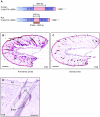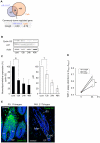Expression of a constitutively active calcineurin encoded by an intron-retaining mRNA in follicular keratinocytes
- PMID: 21423799
- PMCID: PMC3056713
- DOI: 10.1371/journal.pone.0017685
Expression of a constitutively active calcineurin encoded by an intron-retaining mRNA in follicular keratinocytes
Abstract
Hair growth is a highly regulated cyclical process. Immunosuppressive immunophilin ligands such as cyclosporin A (CsA) and FK506 are known as potent hair growth modulatory agents in rodents and humans that induce active hair growth and inhibit hair follicle regression. The immunosuppressive effectiveness of these drugs has been generally attributed to inhibition of T cell activation through well-characterized pathways. Specifically, CsA and FK506 bind to intracellular proteins, principally cyclophilin A and FKBP12, respectively, and thereby inhibit the phosphatase calcineurin (Cn). The calcineurin (Cn)/NFAT pathway has an important, but poorly understood, role in the regulation of hair follicle development. Here we show that a novel-splicing variant of calcineurin Aß CnAß-FK, which is encoded by an intron-retaining mRNA and is deficient in the autoinhibitory domain, is predominantly expressed in mature follicular keratinocytes but not in the proliferating keratinocytes of rodents. CnAß-FK was weakly sensitive to Ca(2+) and dephosphorylated NFATc2 under low Ca(2+) levels in keratinocytes. Inhibition of Cn/NFAT induced hair growth in nude mice. Cyclin G2 was identified as a novel target of the Cn/NFATc2 pathway and its expression in follicular keratinocytes was reduced by inhibition of Cn/NFAT. Overexpression of cyclin G2 arrested the cell cycle in follicular keratinocytes in vitro and the Cn inhibitor, cyclosporin A, inhibited nuclear localization of NFATc2, resulting in decreased cyclin G2 expression in follicular keratinocytes of rats in vivo. We therefore suggest that the calcineurin/NFAT pathway has a unique regulatory role in hair follicle development.
Conflict of interest statement
Figures





Similar articles
-
Cyclosporin A-induced hair growth in mice is associated with inhibition of calcineurin-dependent activation of NFAT in follicular keratinocytes.Am J Physiol Cell Physiol. 2003 Jun;284(6):C1593-603. doi: 10.1152/ajpcell.00537.2002. Am J Physiol Cell Physiol. 2003. PMID: 12734112
-
Localization of calcineurin/NFAT in human skin and psoriasis and inhibition of calcineurin/NFAT activation in human keratinocytes by cyclosporin A.J Invest Dermatol. 2002 May;118(5):779-88. doi: 10.1046/j.1523-1747.2002.01709.x. J Invest Dermatol. 2002. PMID: 11982754
-
Cyclosporin a inhibits calcineurin/nuclear factor of activated T-cells signaling and induces apoptosis in retinoblastoma cells.Invest Ophthalmol Vis Sci. 2005 Mar;46(3):782-90. doi: 10.1167/iovs.04-1022. Invest Ophthalmol Vis Sci. 2005. PMID: 15728531
-
Regulation of MAPK signaling pathways through immunophilin-ligand complex.Curr Top Med Chem. 2003;3(12):1358-67. doi: 10.2174/1568026033451916. Curr Top Med Chem. 2003. PMID: 12871167 Review.
-
Inhibitors of the calcineurin/NFAT pathway.Curr Med Chem. 2004 Apr;11(8):997-1007. doi: 10.2174/0929867043455576. Curr Med Chem. 2004. PMID: 15078162 Review.
Cited by
-
Re-Evaluating Cyclosporine A as a Hair Growth-Promoting Agent in Human Scalp Hair Follicles.J Invest Dermatol. 2015 Aug;135(8):2129-2132. doi: 10.1038/jid.2015.121. Epub 2015 Mar 31. J Invest Dermatol. 2015. PMID: 25826423 No abstract available.
-
In Vitro Studies to Define the Cell-Surface and Intracellular Targets of Polyarginine-Conjugated Sodium Borocaptate as a Potential Delivery Agent for Boron Neutron Capture Therapy.Cells. 2020 Sep 23;9(10):2149. doi: 10.3390/cells9102149. Cells. 2020. PMID: 32977522 Free PMC article.
-
Cyclosporine-induced alopecia:a case report, FDA adverse event reporting system analysis and literature assessment.Front Pharmacol. 2024 Aug 28;15:1453034. doi: 10.3389/fphar.2024.1453034. eCollection 2024. Front Pharmacol. 2024. PMID: 39263573 Free PMC article.
-
Identifying novel strategies for treating human hair loss disorders: Cyclosporine A suppresses the Wnt inhibitor, SFRP1, in the dermal papilla of human scalp hair follicles.PLoS Biol. 2018 May 8;16(5):e2003705. doi: 10.1371/journal.pbio.2003705. eCollection 2018 May. PLoS Biol. 2018. PMID: 29738529 Free PMC article.
-
Identification of functional, short-lived isoform of linker for activation of T cells (LAT).Genes Immun. 2014 Oct;15(7):449-56. doi: 10.1038/gene.2014.35. Epub 2014 Jul 10. Genes Immun. 2014. PMID: 25008862
References
-
- Paus R, Cotsarelis G. The biology of hair follicles. N Engl J Med. 1999;341:491–497. - PubMed
-
- Jiang H, Yamamoto S, Kato R. Induction of anagen in telogen mouse skin by topical application of FK506, a potent immunosuppressant. J Invest Dermatol. 1995;104:523–525. - PubMed
-
- Gafter-Gvili A, Sredni B, Gal R, Gafter U, Kalechman Y. Cyclosporin A-induced hair growth in mice is associated with inhibition of calcineurin-dependent activation of NFAT in follicular keratinocytes. Am J Physiol Cell Physiol. 2003;284:C1593–C1603. - PubMed
Publication types
MeSH terms
Substances
LinkOut - more resources
Full Text Sources
Molecular Biology Databases
Miscellaneous

